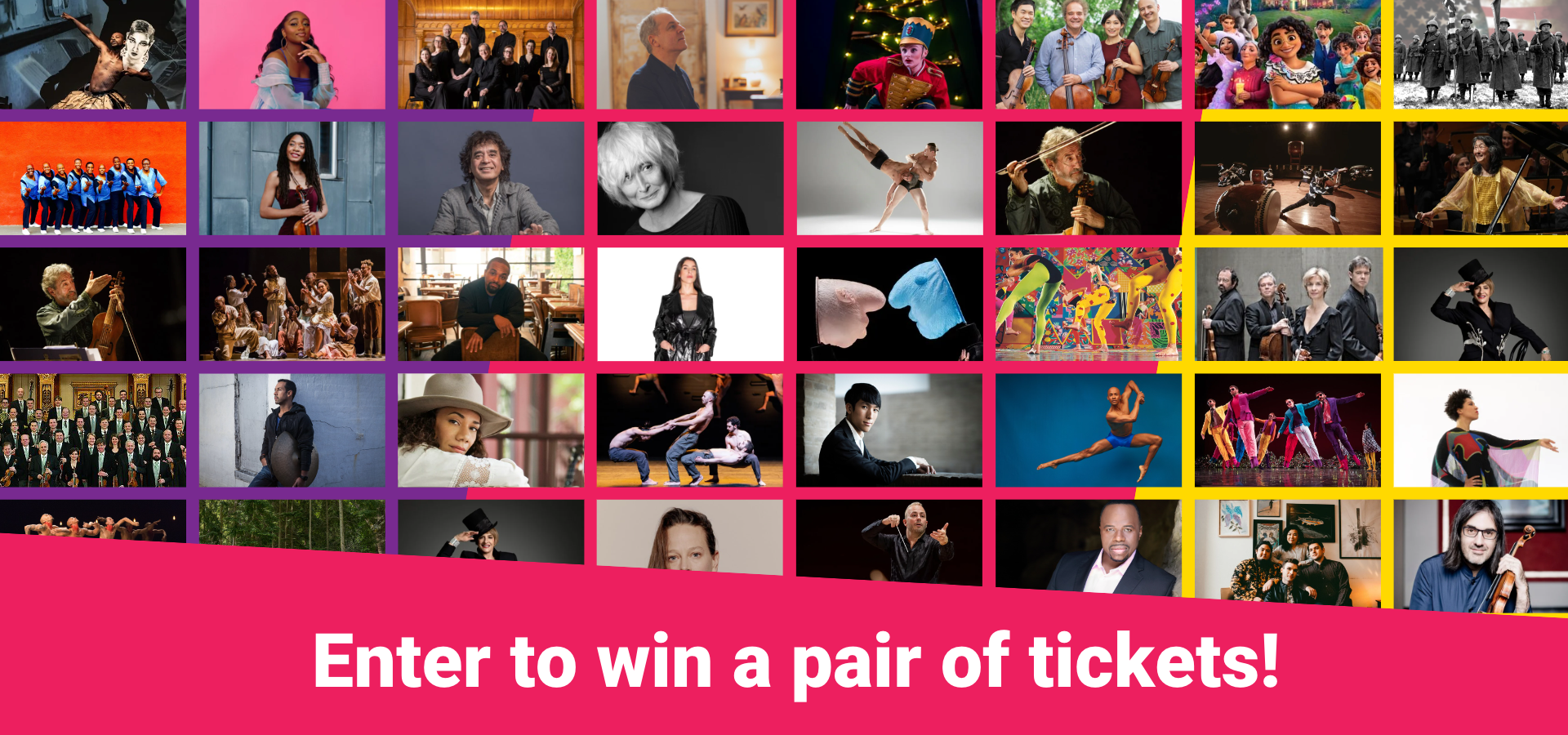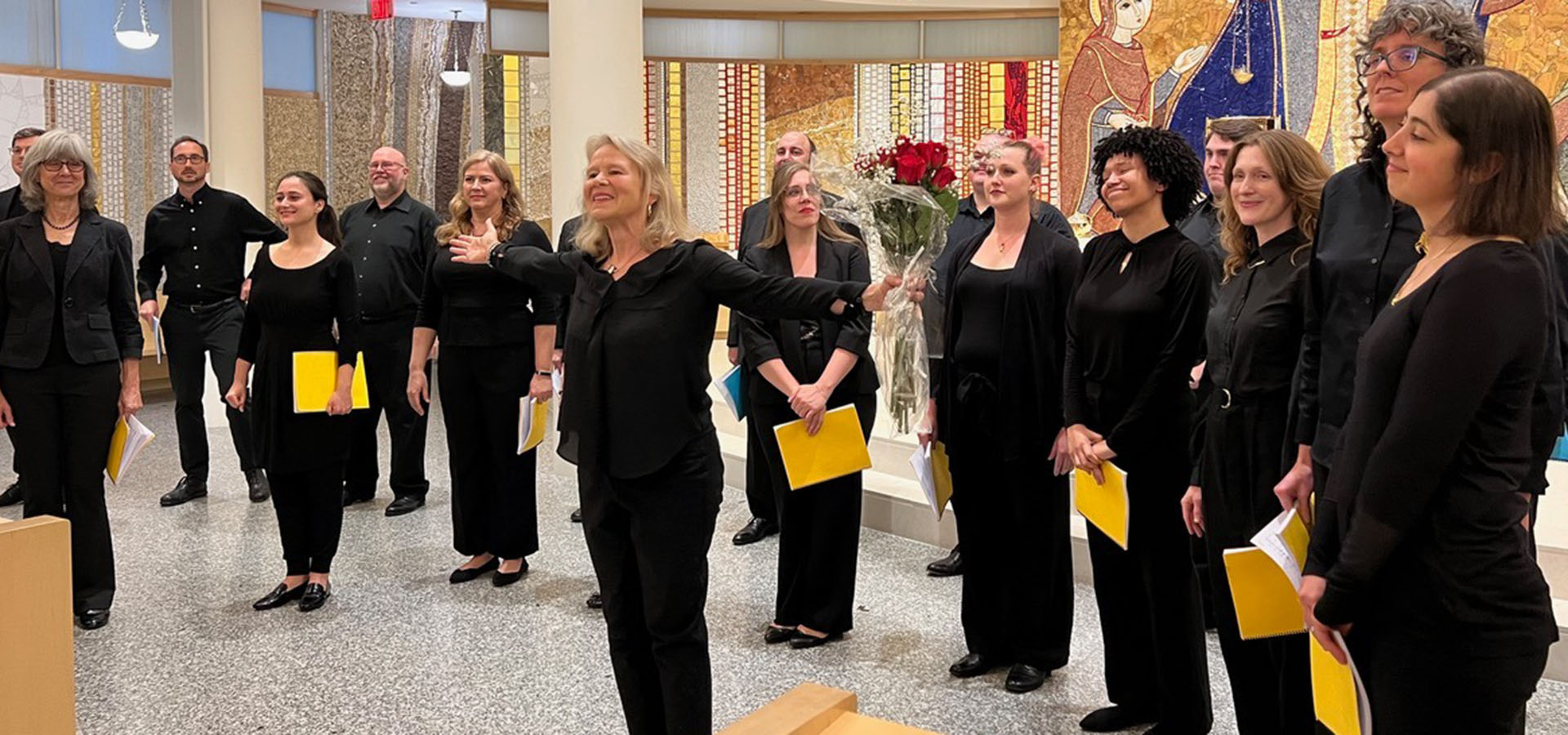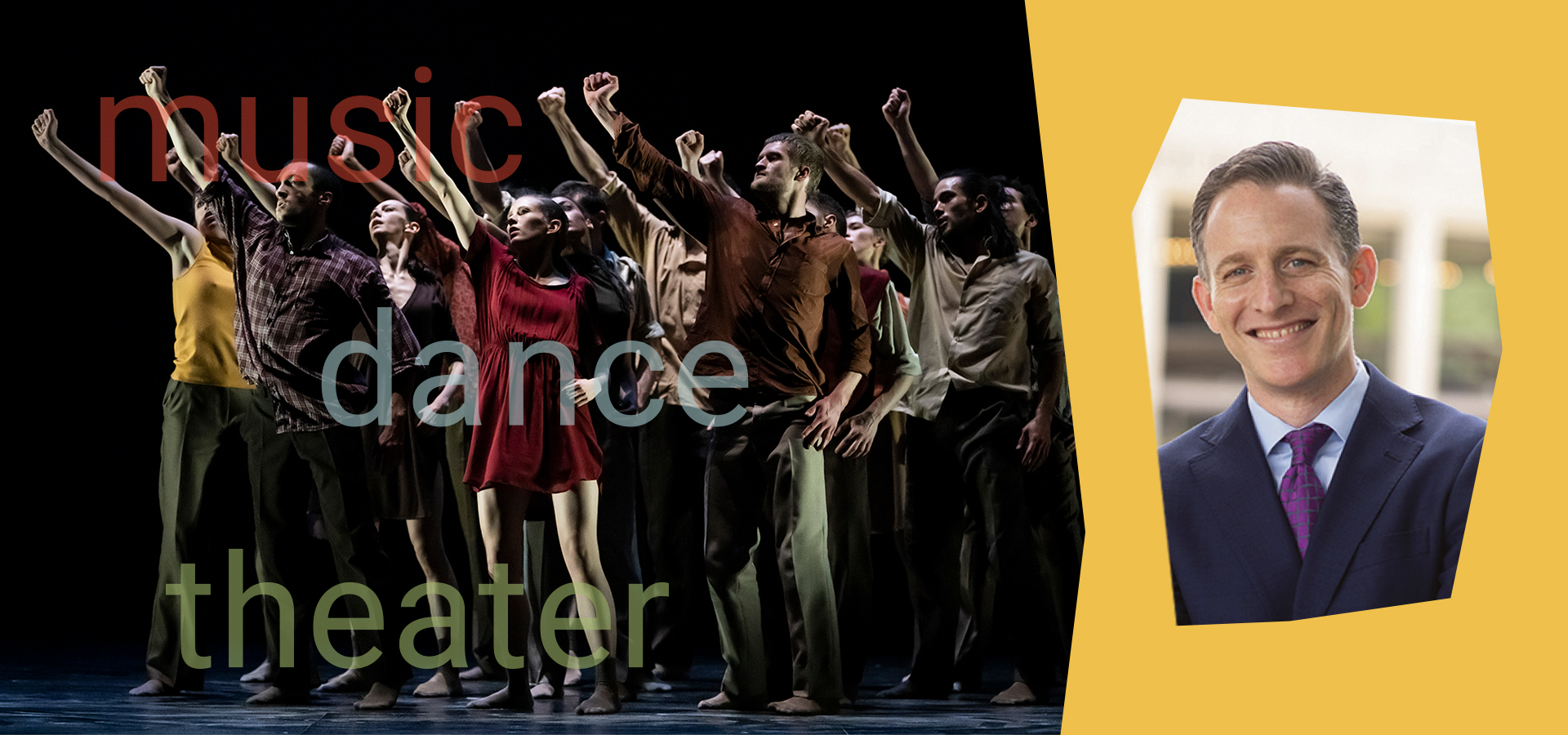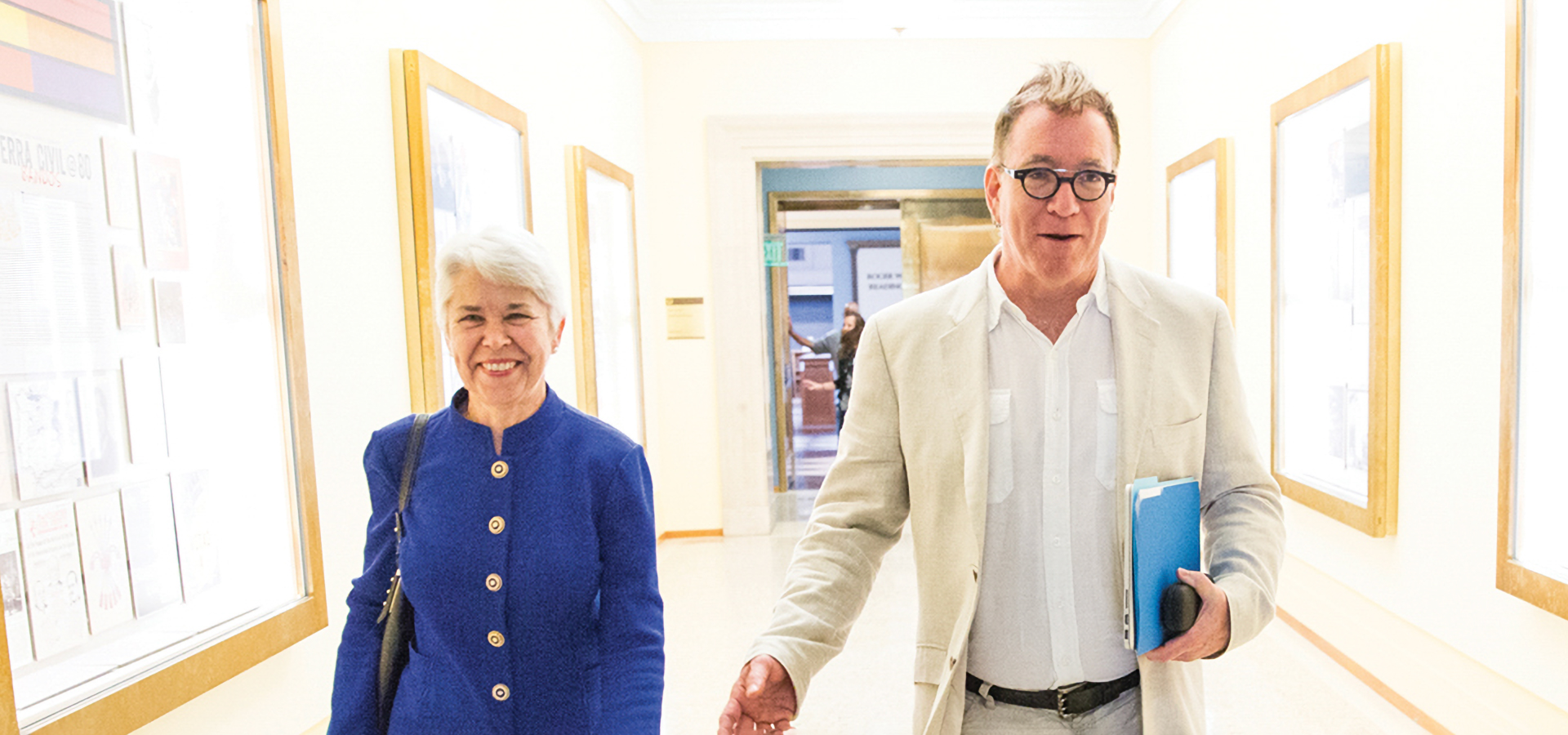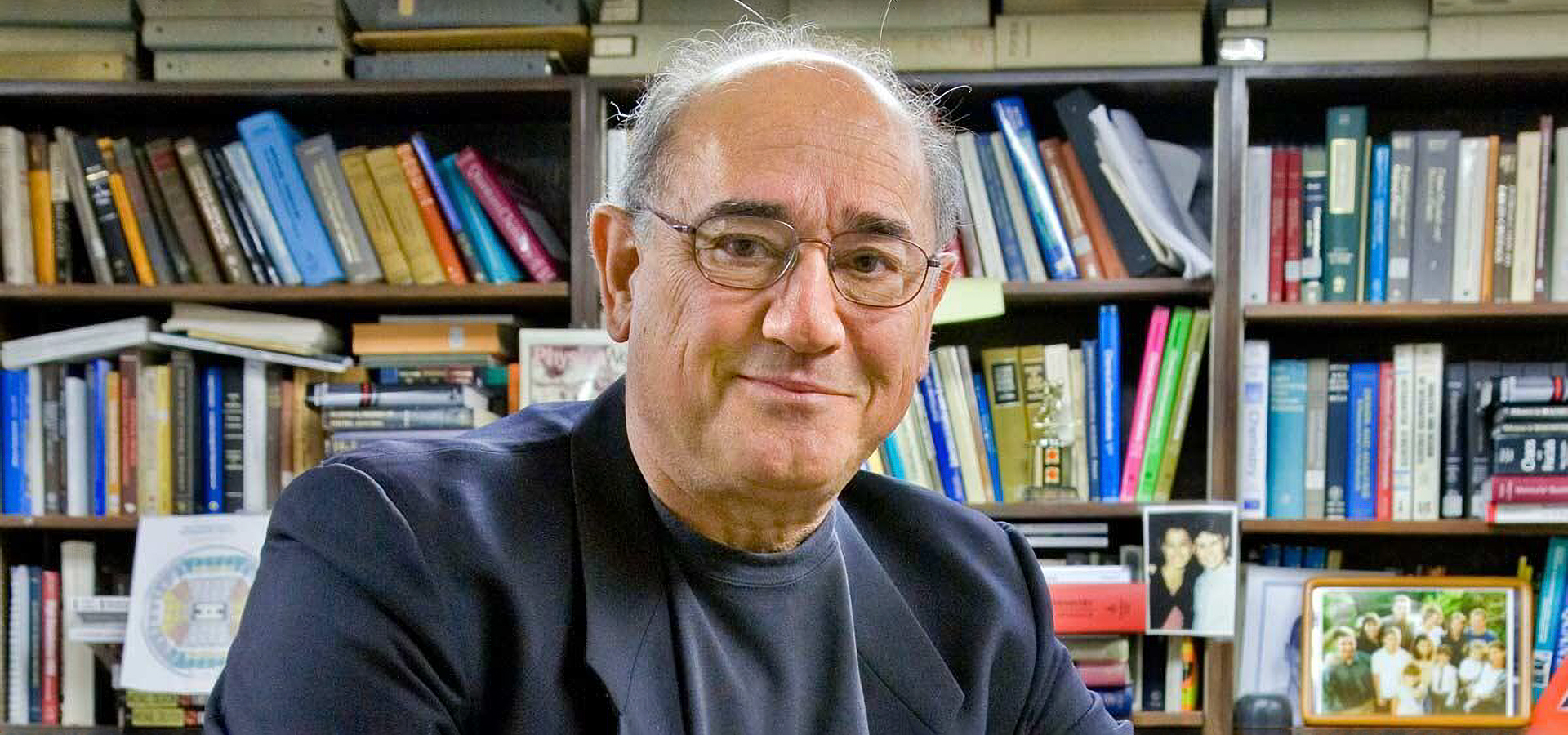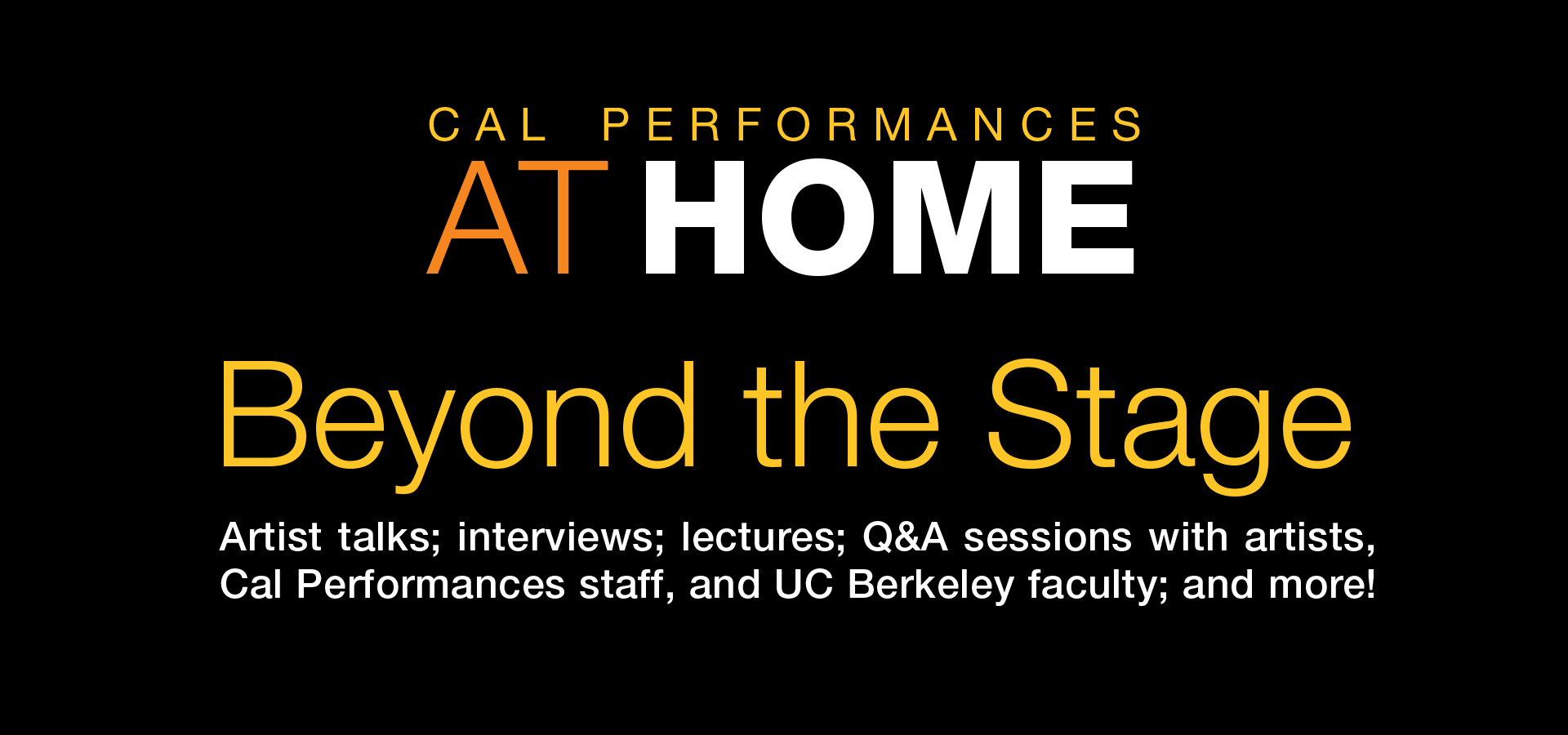
Cal Performances at Home is much more than a series of great streamed performances. Fascinating behind-the-scenes artist interviews. Informative and entertaining public forums. The Cal Performances Reading Room, featuring books with interesting connections to our Fall 2020 programs. For all this and much more, keep checking this page for frequent updates and to journey far, far Beyond the Stage!
Major support for Beyond the Stage is provided by Bank of America.
Beyond the Stage
Transfixing Art: Julia Bullock Launches Her Cal Performances Artist Residency
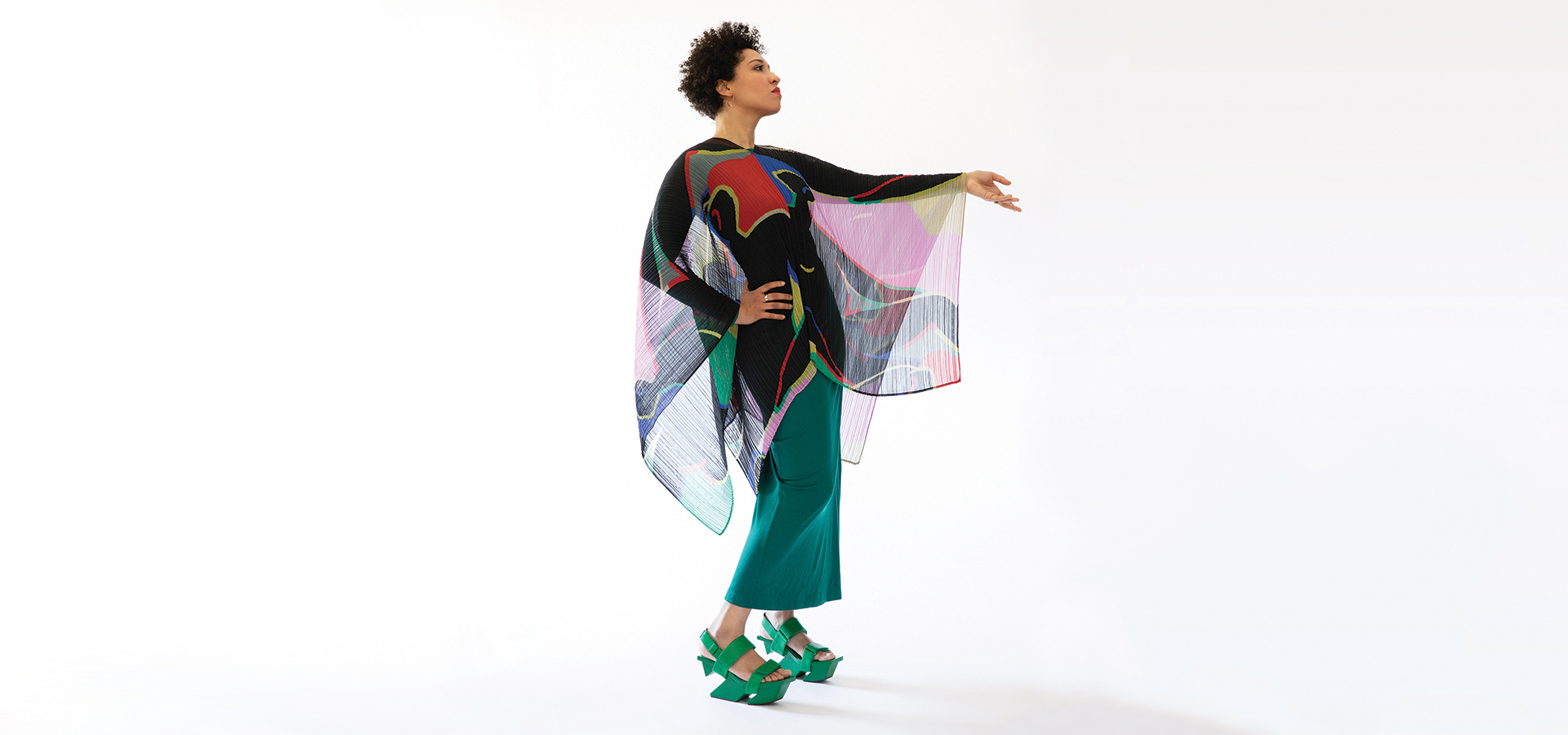
Transfixing Art: Julia Bullock Launches Her Cal Performances Artist Residency
Collaborative Creativity and the Expansion of Harawi
By Thomas May, Cal Performances-commissioned writer, critic, educator, and translator
The first time Julia Bullock heard Harawi, Olivier Messiaen’s song cycle from 1945, she recalls that both the poetry and the music “shook me to a fundamental core … even though I didn’t fully grasp the depths of the content and the references on first listen.”
The internationally acclaimed classical singer collaborated with her colleagues in the American Modern Opera Company (also known as AMOC*, of which she is a founding member) to create a boldly original staged production of Messiaen’s work, which was premiered in the summer of 2022 at the Festival Aix-en-Provence and subsequently toured across Europe.
Cal Performances presents the United States premiere of this production to launch its 2024–25 season of performing arts (September 27, Zellerbach Hall). At the same time, the event inaugurates Julia Bullock’s season-long artist residency at Cal Performances. She will return for a second engagement to perform a very different program when she joins the Orchestra of the Age of Enlightenment, one of the world’s pre-eminent period-instrument ensembles, early in the new year (January 19, 2025, also at Zellerbach Hall). Her presence as artist-in-residence additionally includes interactions with the UC Berkeley campus and broader community during two campus visits. These will involve a series of conversations and public and private programs in conjunction with her performances.
Committed to Musical Meaning
It was more than a decade ago that Bullock first fell in love with Harawi. The work so captivated her that she spent a day immersed in “the poetry and also all of the various recordings that I could find of this 50-minute song cycle that Messiaen wrote for voice and piano,” Bullock says.
Determined to develop a program around Harawi, she envisioned various configurations to bring it to life onstage. It took five years “to find the team and the time to gather the forces together to support this iteration of the piece.” Bullock is especially proud of what she and her AMOC* colleagues—director Zack Winokur, pianist Conor Hanick, and choreographers/dancers Bobbi Jene Smith and Or Schraiber—have been able to achieve: “The dedication is fierce from everyone involved, and I do feel it radiates off of all aspects of this work.”
The intensity of her response to the potential of Messiaen’s song cycle strikes a familiar note to anyone who has experienced Bullock’s artistry. The expressive warmth and luminosity of her soprano envelope the listener but have an edge: her voice is “shot through with steel,” as Musical America put it when naming Bullock one of its 2021 Artists of the Year. The arresting beauty of her singing would in itself be enough to make her one of the great singers of our time.
Yet this is merely the outer layer of her deeply thoughtful, deeply informed approach to conveying the meaning embodied in a piece of music. Much as Bullock herself was affected by her Messiaen discovery, her ability to forge powerful emotional connections with whatever she chooses to sing in turn makes an indelible impact on her audience.
“In addition to having a beautiful instrument and all of the technical resources that a great singer needs, there are an indescribable magnetism and curiosity to Julia Bullock that transfix everyone who hears her,” says Jeremy Geffen, Executive and Artistic Director of Cal Performances.
Geffen recalls that the first time he heard Bullock sing was when she was still a student at the Juilliard School and had been selected as an alternate for a master class led by Jessye Norman at Carnegie Hall. “Since master class singers never really get to hear each other, Ms. Norman had the unusual idea of asking them all to sing for each other the night before. I heard Julia sing ‘Résurrection’ from Messiaen’s Chants de Terre et de ciel [“Songs of Earth and Heaven”].” What followed was “a moment of deafening silence—that moment where you hear the proverbial pin drop.”
Redefining the Singer’s Role
Over the past decade, Bullock, who was born in 1986 in St. Louis, has not only established herself as a leading performer of her generation but has become widely admired as a thought leader in the field. Her innovative programs, advocacy for historically marginalized voices, engagement with new music, activism, and commitment to making the arts more equitable for all reflect a far more encompassing understanding of what being a 21st-century singer means. For Geffen, “Julia Bullock is a perfect example of what an artist-citizen can look like today.”
In the Bay Area alone, for example, Bullock has been showing the astonishing range of her interests through appearances in multiple venues. She first sang at UC Berkeley in 2016 as a featured performer in the Ojai at Berkeley festival (in Kaijo Saariaho’s La passion de Simone and Josephine Baker: A Portrait, with music by Tyshawn Sorey).
The following year marked Bullock’s debut at San Francisco Opera, where she created the role of Dame Shirley in the world premiere of Girls of the Golden West by John Adams—one of several leading contemporary composers who have been inspired to write for Bullock’s unique combination of vocal and theatrical presence. (She also sings on the work’s debut recording, made with the Los Angeles Philharmonic made with the Los Angeles Philharmonic with Adams conducting, which was released this past spring and selected as an editor’s choice by Gramophone magazine.)
Bullock is also widely in demand in concert halls, as exemplified by her close association with the San Francisco Symphony. She served as a collaborative partner with Esa-Pekka Salonen following her residency there during the 2019–20 season. Bullock has also held residencies with London’s Philharmonia Orchestra and Guildhall School and was even chosen to be artist-in-residence at the Metropolitan Museum of Art in New York in 2018-19.
The past season has been replete with fresh career landmarks. Bullock made her Metropolitan Opera debut in a lauded new staging of John Adams’ El Niño directed by Lileana Blain-Cruz and conducted by Marin Alsop. Bullock’s close connection to that work is evident in a related project with which she has toured: El Niño: Nativity Reconsidered, a distilled, chamber orchestra version of the original arranged by her husband, the conductor and pianist Christian Reif.
“Over the course of my life, there have been only a few musicians whose material had me transfixed to such an intense degree after having listened to it for only a few minutes,” Bullock writes in her “note” to Nonesuch’s 2022 edition of the Collected Works of John Adams. “Messiaen’s music certainly did that for me … and after listening to El Niño, I could say the same about John Adams.”
Bullock also made her debut at Barcelona’s fabled Gran Teatre del Liceu in the European premiere of another Adams opera, Antony and Cleopatra, singing the role of the Egyptian queen that was written with her voice in mind. (She had had to withdraw from the world premiere at San Francisco Opera in 2022 while expecting her first child.) Meanwhile, Bullock won the 2024 Grammy Award for Best Classical Solo Vocal Album for her solo debut album, Walking in the Dark, made in collaboration with Reif.
A Two-Way Street
“One of the things I especially admire about Julia is her artistic restlessness,” says Geffen. “She has never wanted to simply be plugged into a grid of roles—although, obviously, she can sing the standard repertoire extremely convincingly, and that has its place in her career. For Julia, creation is a two-way street.”
Along with portraying familiar characters by composers like Mozart, Massenet, and Janáček, Bullock shapes lesser-known roles in collaboration with contemporary artists. Sometimes this involves a radical reconsideration of material written centuries ago, as
with her much-noticed interpretation of the title role in Henry Purcell’s 1695 “semi-opera” The Indian Queen. That production, which critiqued issues of colonization in the original, was directed by Peter Sellars, who has been an important mentor for Bullock.
Bullock has also reimagined Handel’s Theodora in a probing, modern-day staging at the Royal Opera House directed by Katie Mitchell. A previous collaboration with Mitchell in 2019, Zauberland (“Magic Land”), was prompted by the plight of Syrian refugees and interwove lieder by Robert Schumann with new songs by the composers Bernard Foccroulle and Martin Crimp to address issues of grief and displacement.
Embodying Duality in Harawi
Messiaen’s Harawi exemplifies the layered approach to existing sources that has become a signature of Bullock’s work. A relatively early piece, Harawi is the last of three song cycles the French composer wrote for voice and piano. The title comes from an ancient Andean tradition—known as yaraví to Spanish speakers and nowadays particularly linked with Peru—that combines Quechua poetry, music, and ritual. Harawi songs typically express the pangs of lost love but can also address other types of sorrow; meditation on death is likewise an important feature.
Messiaen wrote not only the music but his own texts for this cycle of a dozen songs, imbuing each poem with his dreamlike, spiritually tinged brand of Surrealism. He amalgamated traditional harawi imagery of love and death with his interpretation of the European myth of Tristan and Isolde—though these figures make no explicit appearance in the cycle: the Isolde prototype is called Piroutcha, while her lover is never named.
The dramatic soprano Marcelle Bunlet, whose “flexible voice and extended tessitura” Messiaen admired, inspired the extraordinarily difficult vocal part he composed. “I’ve preserved only the idea of a fatal and irresistible love, which, as a rule, leads to death and which, to an extent, invokes death,” Messiaen wrote, “for it is a love that transcends the body, transcends even the limitations of the mind, and grows to a cosmic scale.”
“The piece deals with duality and actually dichotomies in pretty extreme ways,” says Bullock. “So, the love relationship, life and loss; spirituality and sensuality; feeling connected or in communion with oneself and those around, and then dismissed or forgotten; and the embodiment, or—maybe better—the full expansions of being a man and a woman.” Visualizing and making concrete this duality and, with it, the physical, human aspects of Messiaen’s songs became a priority.
For Bullock, this called for a multiplication of performers beyond the original duo specified (singer and pianist) by the composer. “Because the performance arts practice of harawi also incorporates dance, I thought, ‘Okay. Well, what if we added dancers into the mix?’” Thus this production of Harawi evolved into its expanded cast featuring additional members of the company along with Conor Hanick as the pianist. The husband-wife team Bobbi Jene Smith and Or Schraiber participate as choreographers/dancers in a staging that matches the music with eloquent movement.
For his vision as director, AMOC* cofounder Zack Winokur suggested a link between Harawi’s mythic, archetypal aspects and Messiaen’s personal experience of loss as his first wife, violinist Claire Delbos, suffered a degenerative mental illness. Regarding the performance originally scheduled for the 2022 Ojai Festival, for which AMOC* served as curator (cancelled at the last minute when Bullock tested positive for COVID), he said: “What is it to maintain connection with someone who is losing their memory and, as they’re moving through time with you, to realize all of the things that you’ve created with them are going away?”
Illuminations: “Fractured History”
Harawi also launches Cal Performances’ new theme for this season’s focus in the ongoing Illuminations series, an initiative intended to grapple with pressing issues of our time through the lens of the performing arts.
The theme, “Fractured History,” is about the dynamic reality of history (in contrast to commonplace perceptions of the past as a static “given”). That dynamic character is inextricably connected to and reflected by how we perceive, examine, and narrate history. “Our understanding of ourselves, the culture in which we live, grows based on new information or influences that come to us,” as Geffen puts it.
With respect to Messiaen’s Harawi, the perspective of “fractured history” means interrogating the relationship between a French composer in mid-20th-century Europe and his allusions to an ancient Andean tradition of singing and folklore.
“In addition to the Andean tradition, you also have to take into account Messiaen’s fascination with the Tristan myth, for example,” says Geffen. “So you’re getting impressions of impressions. What does revisiting a source material at a specific time—nearly 80 years after Harawi was created—reveal to us about the culture in which that reflection was made?” He adds that Harawi was not originally intended to be staged. Thus, with the doubling of singer-pianist through the dancer-couple, “you’re getting a reflection through this staging that is reflective of the piece. So it’s a reflection of a reflection of a reflection.”
For Bullock, the “fractured history” angle is closely related to questions of appropriation, which are “big and important.” Messiaen’s knowledge of the authentic Andean tradition seems to have been limited to a folk song collection published in 1925 by a French ethnomusicologist and her husband. Bullock decided to seek out present-day practitioners of harawi and came across two women who danced and sang traditions that had been passed down. They lived in Germany, where the singer and her family also make their home (in Munich).“We just had a bunch of conversations,” she says. “With fractures in our consciousness, part of the joy—at least I feel as a musician, and I guess an anthropologist in some maybe amateur way—[is that] I’m healing some of those fractures, or at least trying to rebuild some things.”
“I deal with classic art and the classics. All that means really is that we are returning to the material again and again, hoping that it will become more illuminated or we will somehow become more illuminated in the process and learn something. As long as we are responsibly engaging with material—and that means looking at history closely—then the cycle of appropriation and the erasure that sometimes or often accompanies it can be halted and potentially healed.”
Related Posts
There are no related posts yet. Check back soon!
Berkeley Front Row Music & Arts Festival Giveaway
Berkeley Front Row Music & Arts Festival Giveaway
Aug 24, 2024
We’re thrilled to announce a giveaway for 6 pairs of tickets to our 2024–25 season for those of you participating in Berkeley’s Front Row Music & Arts Festival! Our new season includes nearly 80 events ranging everything from cutting-edge dance, including Twyla Tharp Dance, to family-friendly performances like Disney’s Encanto: The Sing-Along Film Concert, to incredible classical music by ensembles such as the Vienna Philharmonic Orchestra!
Entries accepted until Aug 24, 2024 at 11:59pm PT.
To enter, please submit your information below. Good luck!
Giveaway Rules
Entries accepted until Aug 24, 2024 at 11:59pm PT. Maximum one (1) entry per person. Winners will be selected randomly and notified by Sept 7, 2024, via the email with which they entered. Winners will have 24 hours after notification to accept their prize, after which time it will be offered to another entrant. Cal Performances staff is not eligible to enter. The winnings of this prize cannot be sold or redeemed for cash.
Explore the 2024–25 Single Tickets Brochure!
Fun Facts About Our 5 Most Popular Performances

Fun Facts About Our 5 Most Popular Performances
Our Most Anticipated Performances, as Chosen by You!
By Krista Thomas, Cal Performances’ Associate Director of Communications
Tuesday, August 6 marks the day that tickets to all events on our 2024–25 season go on sale individually to the general public. But these won’t be the first tickets sold! Over the past three months, subscription sales have been thriving, and we’ve been crunching the data…
As single ticket on-sale approaches, we know it can be hard to decide which events to prioritize. In this article, we’re sharing a handful of our top-selling events on subscription should you want to take inspiration from your fellow arts lovers on what events are must-sees. Read on to learn fun facts about five of our most popular performances—so far!
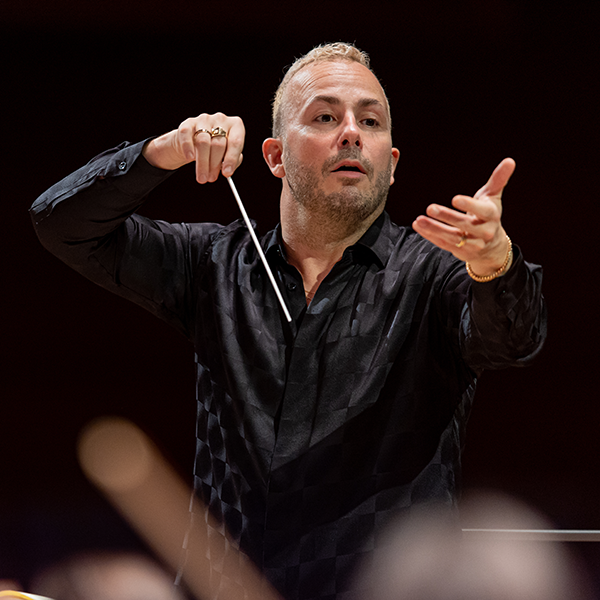
Vienna Philharmonic with Conductor Yannick Nézet-Séguin (March 5–7, 2025)
Our top seller, the Vienna Philharmonic comes to us with star conductor Yannick Nézet-Séguin for three days as part of the Maria Manetti Shrem and Elizabeth Segerstrom California Orchestra Residency, and also serves as the centerpiece of our annual gala! Each evening features a distinct program, with pianist Yefim Bronfman joining on March 7. See the full program.
Did you know?
- Nézet-Séguin recently served as actor Bradley Cooper’s conducting coach as Cooper prepared to play music legend Leonard Bernstein in the 2023 film Maestro.
- The orchestra’s three-night run opens with Mozart’s Symphony No. 41 in C major, K. 551, commonly referred to as Jupiter. The last and longest of Mozart’s symphony compositions, Jupiter is a masterful work that, in its final movement, integrates five different melodies simultaneously.
- The orchestra’s second performance features Dvořák’s Symphony No. 9 in E minor, Op. 95, From the New World. One of the most popular symphonies performed today, this work’s influence has expanded even beyond our own planet: in 1969, it is believed that astronaut Neil Armstrong took a recording of From the New World with him during the first moon landing.
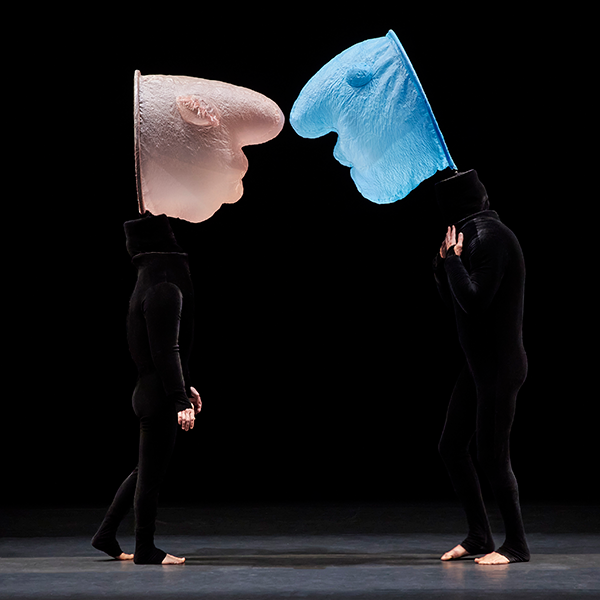
Mummenschanz, 50 Years (October 26–27, 2024)
Famed Swiss mime troupe Mummenschanz returns with a program celebrating the company’s five decades of groundbreaking performance. In a program that is sure to engage the entire family, Mummenschanz resurrects some of its most notable larger-than-life creatures, including Clay Masks, Toilet Paper Faces, and the air-filled Giants (more on these below!). See more on the program.
Did you know?
- Mummenschanz officially formed in 1972 and garnered international attention very quickly. By the end of that decade, they’d had a successful US tour and a multi-year run in Broadway, and were even featured on the popular children’s TV program, The Muppet Show.
- One of the group’s most striking creations, Toilet Paper Faces was debuted as part of the group’s Evolution program in the 1970s. At that time, the piece was actually a spoken sketch, and it wasn’t until later on when Mummenschanz decided to “convert all spoken numbers into mask play” (according to one of their founding members) that the piece transformed into a dramatic love story. (As a bonus fun fact, the group has attested that toilet paper in the US is too delicate to perform this piece, so they have to bring their own toilet paper over from Europe when they perform since it is heavier duty!)
- The air-filled Giants/inflatable faces sketch (as seen in the image above) was first developed with a special material procured in Italy. As the creators were developing the sketch, they noticed how air flow caused the faces to come together and, when the air stopped or changed, break contact with one another, which inspired the emotional milieu that underpins the work.
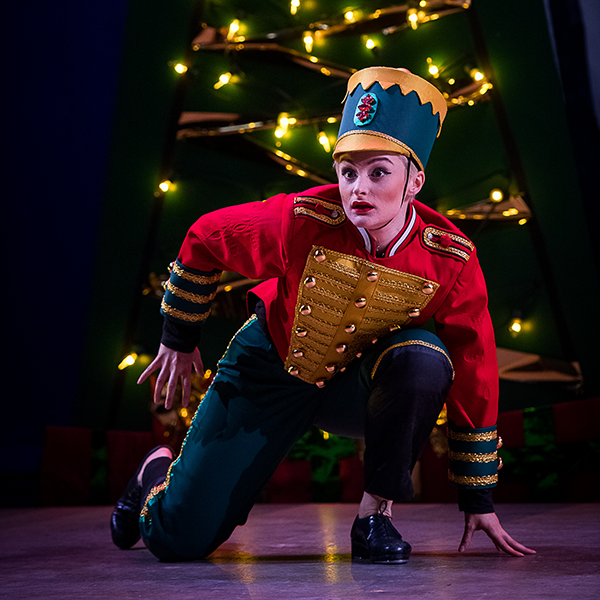
Dorrance Dance, The Nutcracker Suite (December 14–15, 2024)
Just in time for the holidays, tap dance meets hot jazz rhythms in Dorrance Dance’s explosive production of The Nutcracker Suite, danced to Duke Ellington and Billy Strayhorn’s inventive reinterpretation of the classic Tchaikovsky score. See more on the program.
Did you know?
- Developed in 1960, The Nutcracker Suite album was conceived by Strayhorn and represented Ellington’s first album that takes up the work of another composer. In 2018, Penguin Random House published a children’s book that tells the story of the music’s creation.
- One of the co-creators of the work, Josette Wiggan, has expressed that the entire production—set design, costumes, and choreography itself—is all designed to “pay homage to the movers and shakers/creators of [jazz in] the early to mid-1900s.”
- The vibrant, eye-catching costumes for The Nutcracker Suite were designed by New York artist Andrew Jordan, who has worked on sculptural costumes for a wide range of clients: from Broadway shows to fashion brands such as Ralph Lauren and Marc Jacobs, and even celebrity commissions for the likes of Madonna and Heidi Klum.

Orchestra of the Age of Enlightenment with Soprano Julia Bullock (January 19, 2025)
For her second engagement of the season, Cal Performances Artist in Residence Julia Bullock is joined by the famed period-instrument ensemble the Orchestra of the Age of Enlightenment to perform Baroque classics by Handel, Lully, Vivaldi, and Bach, among many others. See the full program.
Did you know?
- Bullock has described this program as “Baroque greatest hits,” and has shared that, rather than treating these works as “clichés,” she is looking forward to “lay[ing] them out boldly and without apology side by side, [to] let audiences enjoy them.”
- As a period ensemble, Orchestra of the Age of Enlightenment is committed to performing works for modern audiences as closely as possible to how they would have been performed at the time the works were created. While you might expect that this would require the use of some instruments whose names you wouldn’t recognize, you might be surprised to learn how many instruments commonly played today were configured differently during the Baroque era. On their website, the orchestra breaks down a variety of period instruments, including the 19th century horn, Baroque clarinet, and Baroque flute.
- Since its creation, the Orchestra of the Age of Enlightenment has had an expressed focus on “equality and inclusiveness.” The group was founded without a music director or conductor, and instead enforces a structure through which the players themselves get to manage the group.
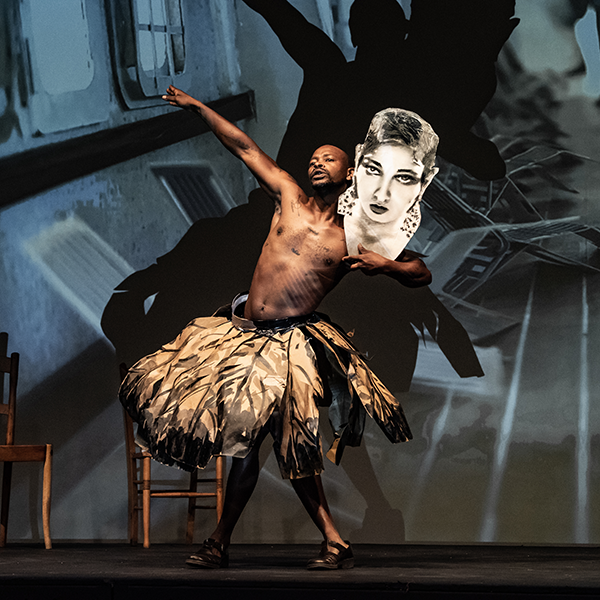
William Kentridge’s The Great Yes, The Great No (March 14–16, 2025)
Internationally acclaimed for his visual art and theater productions, South African artist William Kentridge returns to campus with his latest creation for the stage, the chamber opera The Great Yes, The Great No. The production reimagines a voyage of WWII refugees with a passenger list of iconic historical figures as a way to discuss complex ideas, including cultural exchange and colonization. See more on the program.
Did you know?
- William Kentridge is known for his talent in a wide range of artistic mediums, including drawings (especially charcoal drawings), projections, and sculpture, as well as theater. In this production, Kentridge’s artwork will be on full display on stage, adding a rich visual landscape to the acting and music-making.
- Choral composer Nhlanhla Mahlangu shared that it was important for Kentridge that each performer sings in their native language, since it is a more direct form of expression. At the time of the world premiere, the production featured a beautiful blend of seven different languages: English; French; and South African Isiswati, Isizulu, Isixhosa, Setswana, and Xitsonga! (Don’t worry, there will be subtitles when needed!)
- Contrary to what you might expect, when developing the opera, Kentridge and his team started with the visual and theatrical components, and then evolved a theme secondarily. In a lecture, Kentridge shared that he knew he wanted to utilize large masks and an all-woman chorus, and he even envisioned the ferryman character (who was an iteration of a previous character from The Head & The Load) before the greater message took shape. Once he had collected some of the key visual and performative elements he knew he wanted a stage for, he and his team asked, with these tools, what story can we effectively tell? It wasn’t until Kentridge came across an academic article about the real life journey that would become the backdrop of the opera that the theme began to reveal itself and was expounded upon.
You can learn more about these performances as well as the many others on our season at our season calendar. Can’t wait for single ticket on-sale on August 6, or already know you want to attend multiple performances? Subscriptions are still on sale!
Related Posts
There are no related posts yet. Check back soon!
Director of Artistic Planning Explains: What Is a Performing Arts Presenter?

Director of Artistic Planning Explains: What Is a Performing Arts Presenter?
Katy Tucker draws on her experience working at an orchestra, as an agent, and now as Director of Artistic Planning at a performing arts presenter to overview these distinct avenues for bringing the arts to life!
Interview of Katy Tucker, Cal Performances’ Director of Artistic Planning, by Krista Thomas, Cal Performances’ Associate Director of Communications
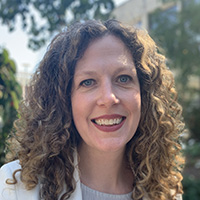 Katy Tucker joined Cal Performances in 2019 and leads the organization’s Artistic Planning team, which (in collaboration with Executive and Artistic Director Jeremy Geffen) manages everything from what goes on the season and when, to what each artist’s contract looks like. A classically trained vocalist, Tucker has served in a variety of roles across the industry. In this Q&A, she draws on her own experience at different types of organizations to explain what a performing arts presenter is, how an organization like Cal Performances hires artists, and the types of choices presenters make/how they work with artists on the type of repertoire/range of styles they can put on stage, among other notable distinctions.
Katy Tucker joined Cal Performances in 2019 and leads the organization’s Artistic Planning team, which (in collaboration with Executive and Artistic Director Jeremy Geffen) manages everything from what goes on the season and when, to what each artist’s contract looks like. A classically trained vocalist, Tucker has served in a variety of roles across the industry. In this Q&A, she draws on her own experience at different types of organizations to explain what a performing arts presenter is, how an organization like Cal Performances hires artists, and the types of choices presenters make/how they work with artists on the type of repertoire/range of styles they can put on stage, among other notable distinctions.
—–
What is the difference between a performing arts presenter (like Cal Performances) and a resident company (e.g., the Metropolitan Opera, Berkeley Repertory Theatre, San Francisco Symphony)?
The two represent different business models, and a different way of programming. A resident company, such as an orchestra or an opera company or a ballet company, employs not only a core staff of professional administrative employees, but also full-time and part-time artists. So, the number of employees is significantly greater, and payroll constitutes a very large part of their annual budget as a result.
As a performing arts presenter, Cal Performances employs a large number of mostly full-time administrative staff, but we do not employ artists full time. Rather, we have short-term contracts that span one or a few days (ranging from one to at most seven performances in that window) with a greater number of artists throughout our season. The variety of our presentations requires a skilled administrative staff focused on education, production, marketing, fundraising, and other business infrastructure necessary to provide our artists with a fertile creative environment in which to deliver world-class performances for our audiences.
How does this difference in business models impact when an arts organization can schedule and what they can program?
If you take orchestras or opera companies for example, most have contracts with their artists that guarantee employment for a certain number of weeks per season. For a large orchestra like my former employer, that’s a 52-week per year contract. This guarantees a certain number of “services” per week, with services being either rehearsals or performances. So, from a programming perspective, resident companies are looking to satisfy their services per week, which causes most opera companies and particularly orchestras to have a very standard schedule of rehearsal days, performance days, and off days each week. Because we as a presenter do not have these types of parameters within which we must schedule, we have far greater flexibility when it comes to the actual calendaring of performances.
And from a programming standpoint, it opens us up to so many different possibilities. Because an orchestra employs a large number of musicians and focuses on orchestral repertoire, they tend to perform programs that feature the majority of their ensemble; it often does not make economic sense to program for a smaller number of musicians. Since we do not have a resident company, we may employ any combination of artists we desire while keeping an eye on finding the right mix of large- and smaller-scale projects.
How does the audience experience differ when regularly attending a repertory company versus a presenter?
Making some generalizations here, if you’re buying a subscription to a residency company, you will mostly see the same performers on stage and/or a similar style of performance. For example, with an orchestra, you’d see the same orchestra week after week, and while the soloists and conductor and the repertoire will change, it will all be within a defined spectrum. With theater, while there will be new productions, you know you’re always going to see straight plays or musicals when going to the same company. This is a great way to deepen your relationship with certain artists as well as to dive deeply into a particular style of performance and all the nuance that comes with it.
The excitement of Cal Performances and other presenters is that, on any given season, you could come a handful of times and experience something incredibly different with each visit. You can truly get a little bit of everything. For example, you can attend an intimate recital and have a really personal and contemplative experience with a single artist; and then the next evening you can see an internationally renowned ballet company and have 50 dancers on stage and as many musicians in the pit, and it’s just spectacle and unbelievable raw talent and discipline. I think one of Cal Performances’ greatest strengths is our commitment to quality, so even if you aren’t entirely certain what it is you’re going to see, you can be assured it has been selected and brought to our stages because it represents excellence, and the very best of what we can put on the stage at that time.
While this question is about audience experience, I do think it’s interesting to briefly talk about how the creative experience differs for the artists, because that can shape your appreciation for what you see on stage. With repertory companies, particularly in dance and theater, those performers may be putting on the same show for 10, 15, 20 performances, and it’s a particular skill set to be able to keep a character fresh and vital during that time—to deliver something night after night that is cohesive and within the general expectation of the production, and yet still find ways to grow the character, to respond to feedback and make new choices and inflections as the run progresses. This process is very different than that of a touring musician, for example, who is in a different hall, a different city, dealing with a different set of energies to adjust to day over day. Variability is built into that performance style, and so it leans more heavily on one’s adaptability to respond to a greater spectrum of variables.
With each artist/company having a different agent and different space and scheduling needs, how do you fit all the pieces together to start building a season at Cal Performances?
On the whole, I’d say that the cycle is as follows for us: when we are two to three seasons out, there are some long-term partners and major artistic investments we know will be on the season in question, but most is still to be determined. It’s around this time that we invest time into talking with agents and listening to artists and others in the industry about what programs might be available during that time frame. We compile all this information and it leaves us with a large pool of projects we could potentially fit together into a season, and then we consider things like the artistic balance of each combination, what our Illuminations theme will be that year, what budget we have to allocate. We also consider what types of performances were on the seasons before and might be on the seasons after so we can represent a wider range of genres across multiple seasons. It’s not generally until fall the season before that the budgeting has been done and enough artists have signed on that I feel much more sure of the general shape of the season, and then it goes from a theoretical plan to something that has to be put into action.
In terms of when each genre of performance is scheduled, every season at Cal Performances is unique. That said, there are a handful of artists, companies, and organizations who we have annual or biannual relationships with, and those traditions provide a great place to start—they lend a certain contour to the season before we fully dive into programming.
In terms of scheduling, typically we start with orchestras and dance companies, often a number of seasons in advance. These performances tend to have a large impact on our budget and require a lot of space and time for both the performance and days of rehearsals. As mentioned previously, orchestras in particular have a lot of structure in their scheduling, so they tend to plan their travel with a lot of lead time. With dance companies, a company is more likely to visit if we can route a west coast tour together with other presenters, so we do the work of coordinating with other presenting colleagues to see if we can collectively entice the dance groups with a rough outline of a tour.
Theater and interdisciplinary projects come a bit later. They seem like they would have a long throw in programming, but because they are often either incredibly ambitious new creations or a reimagining of a work, there tends to be a lot of iteration on their end, especially when it is a premiere. This means that we have a better chance of securing a solid event description and date as well as an understanding of spatial/logistic needs as we get closer to the relevant season. With theater in particular, it can be challenging to find the right kind of performance for Cal Performances because we aren’t built to create a huge infrastructure that would stand for 10 or 20 performances of a piece, which is what most theater companies are used to, so it takes a lot of communication with agents and artists to figure out whether or not the project is a good fit.
Then once we have the more serious artistic pieces determined, we try to add in some more lighthearted entertaining performances to provide a balance. We also schedule our recital series much later in the game. Thankfully, Jeremy Geffen’s intimate knowledge of classical music and his relationship with classical musicians makes the recital series pretty easy to plan, and it just becomes a matter of juggling individual people’s availability, making sure we don’t have the exact same repertoire or style of performance many weekends in a row, etc.
What are the specific things that challenge you and those that excite you in programming in a presenter environment?
The two are the same for me—the specific challenges are the things that I enjoy. The entire process is very complicated, because it’s portfolio management on so many x and y axes that all have to come together at once—the size of the venue, the abilities of the venue you have at your disposal, when the artists are available… Sometimes there are projects we can’t live without, but all the other presenters in our area who want to book it and make up the tour can only schedule around a time that is really challenging for us, and so we have to find ways to make that work. Perhaps the hardest thing for me is accepting when a plan isn’t perfect, but we still need to move forward because it is so important to us to make a commitment to that particular artist, creator, or production.
The fun of programming at Cal Performances is that we have a portfolio of venues that can do nearly anything, and so you have the freedom to do the best of whatever is out there. Many presenter colleagues of mine don’t have that flexibility in their programming—they may have to rent a theater for a specific project, which can be costly, or they may only have the option to use a venue during specific dates. The fact that we can present such an incredible range of performances 365 days a year is really amazing and makes my job that much more exciting.
What is the unique benefit of having a performing arts presenter on the UC Berkeley campus?
The unique benefit of having a presenter in any town is that that presenter is bringing a curatorial perspective on international artists to your city, and bringing along with it a variety of perspectives, traditions, and disciplines to enrich the cultural life of anyone who experiences those artists. In terms of why this is incredible for us in particular, the population of Berkeley is not that large, and so it’s hard to imagine that a city of this size could support a presenter at Cal Performances’ level without the infrastructure of UC Berkeley, without the energy of UC Berkeley, and without the public focus on UC Berkeley that can direct attention to what we are doing.
I grew up in a relatively small town, population of about 30,000, and I had to drive nearly two hours to see anything even close to the level of artistry that Cal Performances is presenting. And that’s life in most places. Having a major university in your town makes it possible for you to have a science museum for kids, fun sports teams to go see on weekends, presenting organizations… It brings an infrastructure and vitality to a city that a small town without a university just cannot support.
There’s also no denying that the curiosity and accumulated energy that result from a large group of people coming together to learn collectively is absolute rocket fuel on the fire of creativity, and it’s wonderful.
Now that we’ve provided an explanation of how all these facets of the performing arts work objectively, could you describe how they have played a role in your own journey working in the performing arts?
I grew up singing and went to NYU to continue my studies in the performing arts, but I had already decided before I enrolled that I didn’t want to pursue a career as a performer. As I was looking for my place in the performing arts, I took a role in the public relations department at the New York Philharmonic, which is where I met Jeremy Geffen, who was a (very young) VP of Artistic Planning at the time. After I had been around the orchestra for a bit, I knew I had an interest in the programming side of things and asked Jeremy if I could be his intern. I began an internship in artistic programming at age 19, which turned into a full-time job after I graduated.
I loved working for an orchestra because—this sounds like something that would be easy to take for granted, but I never did—I had a speaker in my office and I could turn it on and hear the New York Philharmonic rehearsing or performing onstage in Avery Fisher Hall [now David Geffen Hall—no relation to Jeremy Geffen] while I was sitting there doing my emails and writing my contracts, and there was just this immediacy of music-making that is really unbelievable. Just four stories down from me while I was twiddling away at my paperwork , there was an incredibly talented group of people performing at an intensely high level. Jeremy always encouraged me to go down and watch rehearsals, which was really interesting because there were a number of conductors who would come through, each with different styles and interpretations, and layered on top of that you have orchestra members navigating their own way of playing their part or their own interpretation on the music.
So, I loved working at the New York Phil, but after a few years, I realized that I never got to hear any other ensembles perform because I was always in Avery Fisher Hall, and I wanted to branch out. There were two women who represented composers whom I had worked with because the New York Phil had been commissioners on projects they were representing. I was really fascinated by what they did, and through a series of conversations with them, they offered me a job at their publishing firm where I was able to represent artistic creators. In many ways, it was kind of the exact opposite of my job at the Phil: I had no band, I wasn’t connected to any performing arts organization; instead I was connected to composers, I was learning about compositional language and perspectives, and the history that each of those composers carried with them. That role scratched the itch I had to see a range of musicians. I ended up traveling to see orchestras, operas, and chamber music all over the US and Europe. I heard so much new music and I really worked on my listening skills in that job more than anything else, and my ability to think critically about what I had just heard aside from “that was really lovely.”
I did that job for a long time and loved it, although I did get a little burnt out on the travel eventually. When I moved to California, I ventured into this new role at Cal Performances and it turned out, unbeknownst to me, that a presenting organization actually marries these two things that I loved so perfectly: there’s music and art on the stage all the time, and I get to see all kinds of different art. It’s truly the best of the best of both worlds. And from a programming perspective, the sky is the limit, and from an audience perspective, the sky is the limit. I never get bored of what happens at Cal Performances because it’s never the same.
Related Posts
Quiz: Name That Tune!

Quiz: Name That Tune!
From classical compositions to spirituals, to jazz and even Disney hits, our upcoming 2024–25 season is filled with music of every genre, style, and expression! Do you have a keen ear and eclectic taste? Take the quiz to hear 10 musical samples from across our season and see if you can identify the titles of each song/composition!
Make sure to keep track of your answers so you can score yourself at the end, at which point you’ll also have the opportunity to learn more about each piece. Best of luck!
Tags
Related Posts
There are no related posts yet. Check back soon!
Professor, Performer, Content Creator: Meet Cal Performances’ Social Media & Digital Content Specialist

Professor, Performer, Content Creator: Meet Cal Performances’ Social Media & Digital Content Specialist
“One of the big through lines with performing, teaching, and socials, is that it is really all performance to me.”
By Krista Thomas, Cal Performances’ Associate Director of Communications
Tiffany Valvo has been an invaluable member of Cal Performances’ Marketing & Communications team since early 2022. And while you may not recognize her name, you have definitely seen her work, and perhaps even heard her voice in videos! As Social Media & Digital Content Specialist, Valvo creates all the engaging content you see on our social media platforms, produces videos on our Beyond the Stage blog, supports with email graphics and advertising designs, and has even been a key figure in bringing student receptions to life! While her role at Cal Performances is in the digital marketing realm, Valvo has had a number of roles in the performing arts space, including professor, performer, podcaster, blogger, and creator of a very successful digital learning platform for clarinetists. In this article, we dive into her background and how all of her experiences have built on one another to create a holistic approach to engaging with and exciting others about the performing arts.
—
From a young age, Tiffany Valvo felt an incredible draw to music. “My mom definitely sang a lot to us when I was growing up, and I had an aunt who started giving me piano lessons in kindergarten. My paternal grandfather was constantly listening to opera and classical music, and I would sit and listen for hours, too. But one of my earliest musical memories is actually how much I loved singing in Sunday school at church,” she recounted. Her love of music led her to join elementary school choir. But it was in middle school that she truly found her instrument.

Valvo playing the piano with her grandfather.
She joined middle school band in order to learn the clarinet, an instrument she’d heard her cousin play and been very taken by. (She also joined middle school orchestra and learned to play the violin, but admittedly this was only to get out of her school’s PE class!)
“I’d always loved listening to music, but I was especially curious about the sounds people could make when they came together. I liked school and the idea of practicing something specific, having a specific role, but then putting my part together with a big group of people to make something that sounded so much different than what I could make alone. It was the process of making music in community that was really captivating,” she said.
Throughout the rest of her pre-college years, Valvo would invest countless hours into her clarinet between marching band, school orchestra, private lessons, a local youth orchestra, and participating in both the Brevard Music Festival and the Boston University Tanglewood Institute. Valvo pursued a performance degree at Florida State University (FSU) for undergrad, and won her first professional symphony job with the Tallahassee Symphony Orchestra when she was only a junior in college.
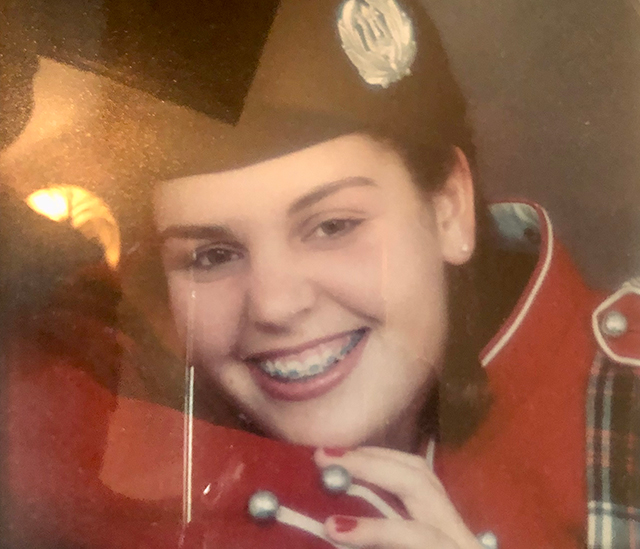
Valvo in her high school band uniform.
“Growing up, I wanted to be a teacher. But at the time that I was entering college, I didn’t really understand that there could be a way for me to cohesively link being a teacher and being a musician without working as a high school or middle school band director. So, I continued to pursue performance.”
It wasn’t until her later years at FSU and into her masters program at the Eastman School of Music in Rochester, New York that she began to look around at the incredible professors and consider that this might be a way to combine her love of educating with her love of playing music at an advanced level. Throughout her time in undergrad, her master’s program, and even during her doctoral program at Eastman, Valvo packed her schedule with her studies, school ensemble performances, professional gigs with established ensembles and orchestras, and teaching roles.
“In my second year at Eastman, I was a teaching assistant and taught a class to music education majors, who are required to learn a little about each instrument. I also taught private lessons to students at the University of Rochester, and was always taking in private students on the side. The last two years of my doctorate, I accepted an instructor role at Nazareth College and taught three sections of an aural skills class Mondays, Wednesdays, and Fridays at 8AM, 9AM, and 10AM. I went on to teach more music theory there, and eventually also taught music theory at Syracuse University,” she said. “Those few years were incredibly intense because there was so much work between practicing my instrument, performing for required school ensembles and professional groups, teaching, and studying for exams. But it truly built up resilience.”

Valvo teaches a master class.
For Valvo, while pursuing so many engagements at once could be tiring, it was energizing at the same time; it felt impossible to give up any one path in favor of another. “I truly loved everything I was doing. Pursuing multiple avenues within the arts was nourishing on so many levels, and I felt like everything was additive to itself, with each avenue enriching my experience of the other.”
After graduating with a DMA in Clarinet Performance, a minor in pedagogy, and an Arts Leadership Certificate, Valvo found near-immediate employment as a clarinet professor at Virginia Commonwealth University (VCU), where she drew on her own multifaceted experience to enrich the experience of her students. “By the time I got to VCU, I was particularly interested in teaching not only the instrument itself, but also how to develop self-efficacy to succeed. During the years I taught previously, I’d encountered many students who were really talented, but they weren’t getting support in forming strong habits, in how to address self-doubt, all these things that are so important for creative people to learn to deal with in a variety of pursuits.”
In response to this gap, Valvo conceived of a class she called The Creative Habit after a book by Twyla Tharp (a featured creator on Cal Performances’ 2024–25 season!). “Being a clarinetist feels so personal, so central to your identity, particularly as you’re in school. I felt it was important to talk about things like forming healthy habits, managing stress, developing confidence in your art—all these things that made me who I was as a professional and that had supported me in all of my artistic pursuits.” She also started a blog and podcast to reach more students about these topics.
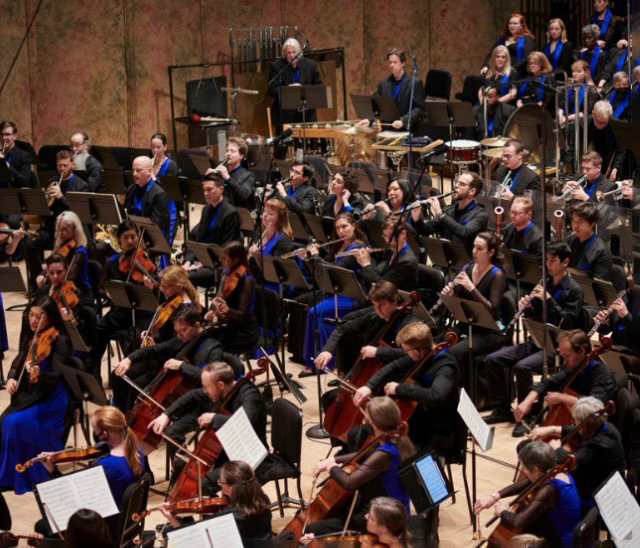
Valvo performs Mahler on clarinet with the Richmond Symphony.
While still performing frequently with the Richmond Symphony and with various chamber groups around the country, plus teaching at VCU, Valvo sat on a marketing committee for the university and was eventually asked to take over the Department of Music’s social media presence. She has gained a handful of digital content skills when starting her blog and podcast, so decided to accept. Never one to shy away from a challenge, Valvo continued to develop a wide array of digital skills through a combination of “a lot of Googling” and taking a sampling of classes in digital creation and copywriting on the side; then evaluating her impact and iterating on what she’d done in the past. While the world of digital creation might seem like a significant departure from her experience performing and teaching, for Valvo, they had clear synergy.
“One of the big through lines with performing, teaching, and socials, is that it is really all performance to me. It all involves an intense creative process, whether practicing to learn a piece, or trying to come up with a creative way to teach someone effectively, or developing content to get someone to understand how incredible a certain performer is… It’s all based in a lot of individual reflection and working on a process so intimately and intricately, and then bringing all that work in front of your core audience and seeing how it lands. When someone gives you feedback that what you’ve thought up or performed impacted them in some way, that’s really the cherry on top,” she said.
In 2020, Valvo expanded her digital experience and impact exponentially when she co-created the Digital Clarinet Academy (DCA), an online teaching platform to reach advanced level clarinet students who lacked in-person instruction during the COVID-19 pandemic. She and her cofounder developed many resources that touched on specific performance skills as well as the soft skills and personal development students needed to succeed. As part of this work, they hosted and taught 200 events, including masterclasses and workshops with over 50 of the leading clarinetists around the world that would reach hundreds if not thousands of students during Valvo’s nearly four years with DCA. While her work at DCA was incredibly time intensive on top of her other roles, “to be able to give people that kind of access and know how valuable it was for them really kept me going,” she said.
In the winter of 2021, Valvo began to transition out of her professorship at VCU due to her family’s relocation to the Bay Area. “I had every possible higher ed alert on for California when I knew we were moving, but I also knew there wasn’t a full time clarinet professor role where we were headed, and I would have to make something work. I saw Cal Performances’ opening for Social Media & Digital Content Specialist and initially shrugged it off because I had thought of myself professionally more so as a professor and educator,” she shared. “But after a short while, I reflected on the digital content skill set I’d developed, particularly in the three years prior, and realized that I had something valuable to contribute. It felt like an opportunity to impact the field of performing arts in a different way than I had previously.”

Valvo with her computer.
While she didn’t know how she would feel working full time in a marketing role, she remained open and committed to sharing her unique perspective in this new context. In the few years that Valvo has been with the organization, she has inspired the entire Marketing & Communications team with her creativity, initiative, and thoughtful understanding of how to reach and excite others, be they students or potential patrons. Notably, she has developed many engaging videos for our Beyond the Stage blog, including educational videos that draw on her background to break down music concepts for the general public; she has expanded the number of social media platforms Cal Performances manages and grown those platforms by thousands; she has established incredible collaborations with both Cal Performances colleagues and artists; and she has been a key proponent of initiatives both with students and with the general public that aim to make the performing arts less intimidating and more accessible and inviting.
“At Cal Performances, what I love is that I’m constantly stimulated by so many amazing performances, and I feel like it’s a constant challenge to figure out a creative way to talk about each one. Also, I really love working with a larger team of people who have more of a background directly in marketing and learning from them. And I love that we are all able to come together to share different perspectives on the arts,” she said. “This role has opened my eyes to a very different side of the performing arts industry and has given me the opportunity to stretch myself to find new ways of getting people invested in the performing arts.”
Unsurprisingly, she has also continued to nourish her multifaceted interests by taking occasional performance gigs, consulting, leading a social media cohort to discuss hot topics in the field amongst other arts organizations, and teaching part time at the San Francisco Conservatory of Music, where she draws on her work at Cal Performances for her classes that teach students how to build and expand their digital presence.
“I’m teaching in a different capacity now, with my classes more focused on digital marketing. Not many music professors are close enough to the marketing side of things to know how to communicate with students just how valuable those skills are in today’s world, and so I’m grateful that I have the opportunity to share my own experience in the digital sphere and all my own examples to help students learn how to promote themselves in a very concrete, evidence-based way,” Valvo said. “It’s yet another example of how the work I’m doing on all these different fronts is feeding into itself and enriching what I am doing in every other dimension. My work at Cal Performances has truly become foundational to all my other work.”
In reflecting on her own journey with the performing arts, and how she sees her professional life unfolding, Valvo shared, “No matter if I’m playing or teaching or doing digital content, my goal is always to get people excited about the performing arts—about clarinet, about music theory, about the many incredible performers that cross our stages. Overall, what I’ve learned is that there’s way more in common about doing those things than there is difference.”
Make sure to follow us on Facebook, Instagram, YouTube, X, TikTok, and LinkedIn to see Tiffany’s stellar work.


